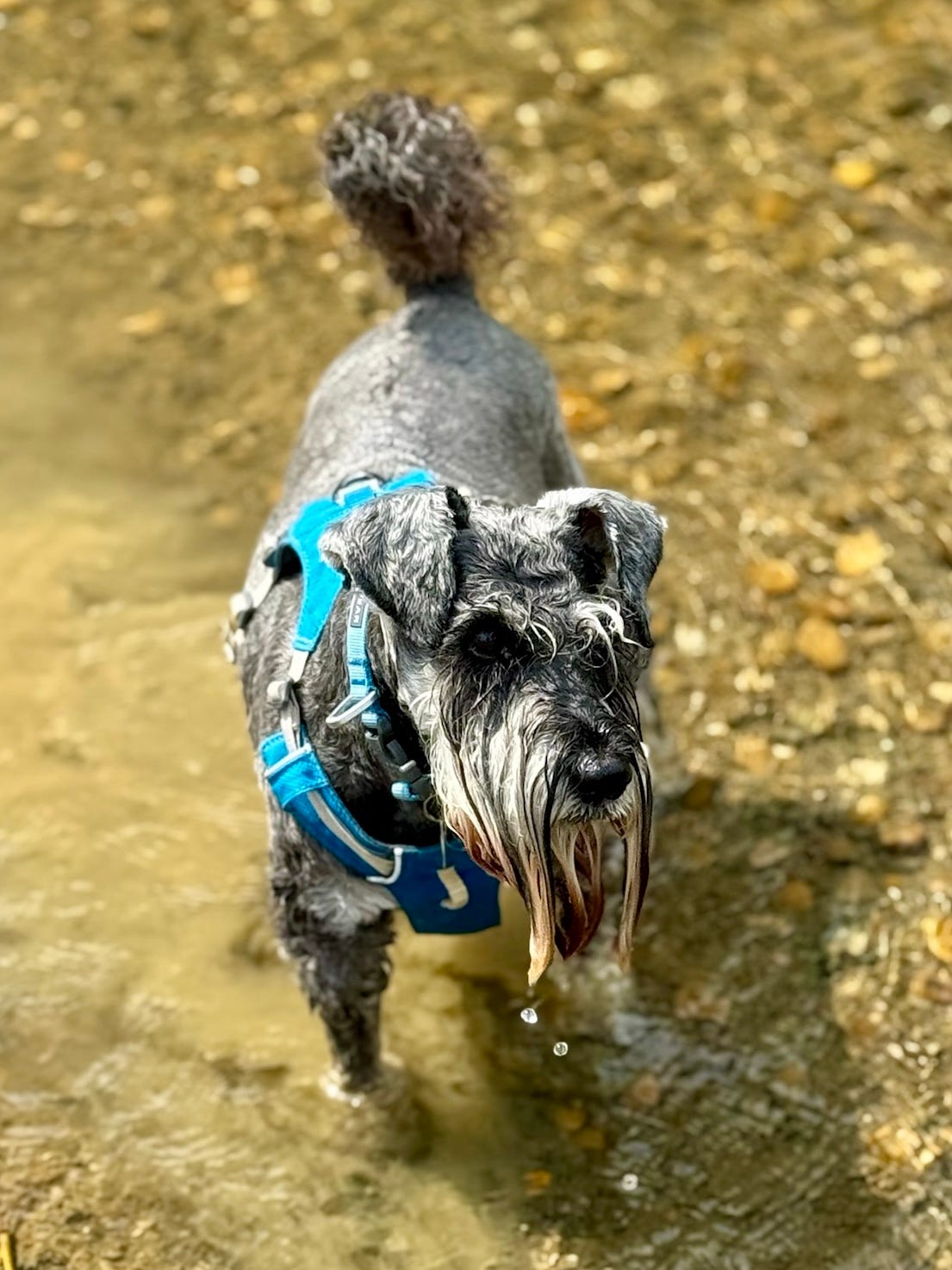How do we know we're right?
When we choose to live with dogs, it is inevitable that at some point we will have to engage with the sad reality that our dogs die. It is not an easy subject and talking about death is always difficult. I believe that the more open we can be in discussing it, the better we can understand what our dogs need from us and make the decisions we have to. But how do we know when our decision not to pursue invasive or further medical treatment for our dogs is right?
The main work of the UK-based charity which I founded, Schnauzerfest, is to pay veterinary bills for dogs. In the five years since Schnauzerfest gained charity registration, I have seen a lot of veterinary invoices, medical records and treatment plans from practices all around the UK, for dogs of all ages. During this time I have also communicated with many dog owners, fosterers, rescuers and adopters and veterinary professionals. Discussing what treatment and care the charity can – and cannot – fund is part of the daily work of Schnauzerfest. Digging into not only the costs that treatment may involve, but also any options which might be available. In today’s era of rapid advances in veterinary medicine, there can often be an abundance of costly, cutting edge options to navigate.
Exploring treatment options is something I have always done with my own dogs. Our vets know to expect plenty of questions and I have never met one who has not been happy that I wish to be involved in the decisions made for my pets. That was always the case in the UK before we moved to France and it remains the same today.
We were still resident in the UK 10 years ago when Susie-Belle was diagnosed with the tumour which was to end her life. While she was elderly, she was enjoying an everyday happiness she had been deprived of during her puppy farm years. We decided not to go the route of more investigations to identfy the tumour type, nor any complex treatment options. The advice was that nothing would change the outcome for her. We decided our remaining time together would be managing symptoms for as long as it was possible. We knew this was the most important thing for Susie-Belle. She never took well to being away from us, even a day’s admission for Xrays greatly distressed her.
It was similar for Twinkle in 2019. When her mobility issues became a problem, our vet offered that we go to Bordeaux for a specialist scan. He advised it most likely would not result in any different treatment from what he was giving. I knew it would stress and likely confuse Twinkle. We decided against the referral.
I have never regretted any of the decisions we have made. Even as I have become increasingly aware of the array of ever more complex treatment and diagnostic options.
Recently I had cause to talk to Sarah, a retired children’s nurse whose dogs Otto and Freddie often appear in wonderful videos she makes of them attending walks for Schnauzerfest. She explained that she hadn’t been as active as usual because seven year old Freddie had been diagnosed with an aggressive form of prostate cancer. At the end of January he underwent a non invasive procedure to embolise the tumour. It wasn’t a cure but aimed to give quality of life for as long as possible.
Sarah had read a piece I’d written a few months previously discussing the difficulties of making decisions, especially in a time of social media.
“I wanted to thank you for writing about end of life decisions for dogs. It was really very helpful. It’s hard to find anything informative on this area, in particular one that addressess the social media aspect and the importance of owners understanding their dogs.”
Sarah’s nursing experience had some influence as she came to terms with Freddie’s diagnosis.
“I have heard families and patients (including me) say that if only they could change a decision about care and treatment. The benefit of hindsight would be a wonderful thing but is not available to us mortals. The best we can do is identify and consider the best available evidence along with insight to make an informed decision. Each case will be unique and the only person who can make that decision is ultimately an informed patient or advocate.
The evidence we used in doing so, may well change as knowledge about the area develops but it is no good chastising ourselves if we later feel the decision we made was not right. It is so important to remember that the decision is made with the best intentions, using time specific evidence and with what was understood and reasoned from this.”
Sarah and I talked about helping Otto when the time came that he would be without Freddie. There are always going to be many unknowns, but I believe that dogs are resilient when tested, and often surprise with their ability to adjust, even when previously they may have had the comfort of not needing to draw upon, or show their resilience.
Yesterday Sarah wrote to tell me that Freddie had died.
“He had become increasingly poorly and weaker over the last week and we had to make the hardest decision, but the kindest one for Freddie. He was an amazing little dog and very determined to enjoy life to the very end by having a last play in his favourite local stream
For what ever reason he could not express his bladder and had stopped eating. Our options were limited as Freddie could not be catheterised as he already had a stent in place. Yes, he could have had further scans and tests that may have led to other procedures, but….
You were right in that dogs can be amazingly resilient. Otto was always a very independent dog, even as a puppy. He would come for a cuddle for a couple of minutes then move away and settle on his own. He came on the bed for a quick goodnight snuggle and then jumped down to sleep in his basket.
We have seen a change. He comes and cuddles all evening and sleeps all night on the bed. Perhaps he senses I need a cuddle.”
It was one of the hardest experiences for us but we were with Freddie to the very end. We were able to then wrap Freddie in a blanket and take him to another room so that Otto could say his goodbye. Otto had a little sniff and made a small whimper but that was it. It struck me that it so was very much like a small child’s reaction to the experience of death.
My original piece of writing which Sarah found helped, shared Pixie’s story. Last autumn, her owner, Doma contacted me wishing to talk about the difficult choices she was facing after Pixie’s cancer diagnosis and the guilt and confusion she was feeling. She told me that seeing the extraordinary lengths some people go to with treatment made her doubt her decision not to pursue more for her dog.
When Pixie left the breeding industry in 2022 aged around 8-10 years old she spent just a few days in foster care before her adoption by Doma. Within two weeks, Pixie fell dangerously ill with acute haemorrhagic gastroenteritis. For six weeks she was very sick, but during that time she learnt to trust Doma who nursed her at home, as visiting the clinic stressed Pixie too much.
Removal of a mast cell tumour from Pixie’s leg happened early last year and she recovered quickly. However, a few months later at the start of October, a new swelling appeared: the tumour was back. This time surgery was much more extensive and wound healing was a real issue.
Doma explained that the options for Pixie were not easy,
“The vet discussed more surgery including leg amputation, chemotherapy or a novel new therapy which might give her extra time. I wish that I could give Pixie many, many years safe and happy. But I am choosing not to put Pixie through any further treatment. It traumatises her every time we go to the vets. She doesn’t understand why she’s in pain and can’t go for the walks that she loves.
If the vet is correct, we may have six months together if we do no more treatment. It could be a year if we tried the additional treatments, with no guarantees. But, what we do know is that more treatment would be very traumatic for Pixie.”
Doma chose not to pursue further treatment, but to help Pixie through her recovery from the surgery and then live the rest of the best possible life they could enjoy together.
“This decision is for Pixie. It is not easy when there are other possible choices. But, just because we can, does not mean that we should. It is not because I wouldn’t do everything I could to give her the longest time with me, I absolutely would. But I know that for Pixie, her remaining time is best spent enjoying her life at home with us. We will enjoy our walks, safe in her feeling of love and security.
It breaks my heart and I dread the decisions to come. I am choosing for Pixie because she can’t. But, I know that she clearly tells me when she feels safe and when she does not. And I respect this, and her, and this is the choice I make, for my beautiful Pixie.”
Pixie continues to enjoy her walks and a few weeks ago was pulling Doma up the hills of Pembrokeshire on holiday.
It can be incredibly difficult to know what decisions to make. Especially in the immediate, sometimes urgent and often highly emotional time of making medical choices. For some, treatments like chemotherapy are positive options, for others they are not. All this becomes harder with the presence of social media in our lives, as it can be easy to feel that perhaps we should take every option offered. And if we don’t, or can’t, somehow we are failing our dogs. Owners deserve empathy and kindness, whatever decisions they make.
Every situation is unique. Each case is different and every dog deserves understanding as an individual. This, I feel is all too easily lost when social media is involved. I’ve spoken with people who have doubted themselves and their decisions, sometimes following casual comments made on social media. It can be heartbreaking to wrestle with that doubt.
Publicly sharing less about the ins and outs of a dog’s medical situation, can make treatment decisions easier, or at least less emotionally confusing. Uninvited – or even invited – advice and opinions can sow doubt, confuse, or frankly, be unhelpful. Nobody knows their dog’s medical situation better than an owner and their vet. It is always better in my view to make decisions privately, with guidance from the professionals involved. And, it is always ok to question, respectfully, the professionals, to get to the right decision for our dogs.








